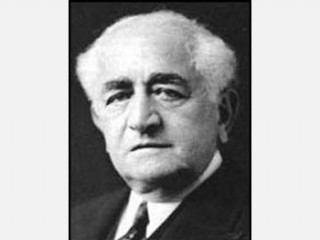
Adolph Simon Ochs biography
Date of birth : 1858-03-12
Date of death : 1935-04-08
Birthplace : Cincinnati, Ohio
Nationality : American
Category : Famous Figures
Last modified : 2010-11-08
Credited as : Newspaper publisher, philantropist, the New York Times
The American publisher and philanthropist Adolph Simon Ochs rose from a cultured but impoverished background to control the so-called ideal newspaper, the New York Times.
Adolph Ochs was born March 2, 1858, in Cincinnati, Ohio. Of German-Jewish stock, he had talent and industry and a disposition that made both productive. He was the eldest of six children and had only a brief exposure to school. However, his father, a teacher fluent in six languages, tutored the boy.
Ochs always referred to the printing office as his high school and college. At the age of 11 he started at the Knoxville Chronicleas office boy, and at 13 he became an apprentice. In 1877 Ochs joined in a fruitless effort to establish the Chattanooga Dispatch. The owner of the Chattanooga Times, victor over the Dispatch, was in difficulty and offered to sell to Ochs, then not old enough to vote. On July 2, 1878, with $37.50 working capital, Ochs became a publisher upon handing over $250, which he had borrowed, and assuming $1,500 in debts. He showed a profit the first year. In 1892 Ochs built the Chattanooga Times Building, an outstanding addition to the developing city.
In 1896 Ochs acquired control of the New York Times. He mortgaged and risked everything to "conduct a high standard newspaper, clean, dignified and trustworthy." The New York Times followed the slogan "All the News That's Fit to Print." From 1896 to 1935 he raised the daily circulation enormously. Ochs started the Sunday book supplement within 10 years after taking over. In 1913 he began publishing the New York Times Index. In 1925 Ochs started advancing $50,000 annually for 10 years toward the cost of producing the Dictionary of American Biography. He established Current History magazine in 1914.
Ochs did not use his papers to express his personality. He "depersonalized" editorship and thought of the New York Times as a public institution. His last active year was 1932; he died April 8, 1935. He had set an example of how to conduct a free and responsible press. According to a biographer, Ochs at times failed because he had been deceived or misinformed "but he never lied …, the final test of a servant of the truth." He had received honorary degrees from six institutions.
Books about Ochs praise him but show little of his personality. Gerald W. Johnson, Honorable Titan: A Biographical Study of Adolph S. Ochs (1946), gives Ochs a glow of glory without humanizing him. Frank Luther Mott, American Journalism: A History of Newspapers in the United States through 260 Years, 1690-1950 (1950), rather stingily gives Ochs his just due, diminishing the halo only slightly. Other helpful works are Elmer Davis, History of the New York Times (1921), Meyer Berger, Story of the New York Times, 1851-1951 (1951); and Gay Talese, The Kingdom and the Power (1969).
















